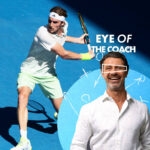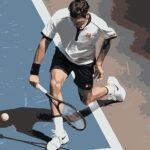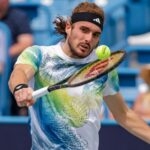Tsitsipas and Dimitrov keeping the one-handed backhand alive
The two men are part of a dying breed of players using just one hand on the backhand
 Zuma / Panoramic
Zuma / Panoramic
Aside from the battle for glory in Indian Wells this year, there’s a nice little sub-plot going on, too, and it surrounds the perilous state – and the uncertain future – of the one-handed backhand.
For generations, the only way to hit the ball on the backhand side, the one-hander has slowly been squeezed out of the men’s game, hastened by the retirement of Roger Federer. In February, for the first time since the ATP rankings began in 1973, there were no one-handers in the top 10.
But if the one-hander is under attack, it’s not quite dead, yet. Sitting at No 11 and 12 in the live ATP rankings are Stefanos Tsitsipas and Grigor Dimitrov, both men still going strong as Indian Wells enters week two, chasing a return to the top 10.
“A complex shot that takes time to master”
For both, the one-handed backhand is a huge part of their game, part of what defines them as players. Both are acutely aware it is under attack but both are determined to make sure it stays in and around the top 10, not least to show young players that it’s a viable alternative to the ubiquitous two-hander, easier to learn, easier to return with.
“It’s a complex shot to master and to perfect, and it takes a lot of time to get to a point where you develop an amazing single-handed backhand, one that is a weapon, too,” Tsitsipas told reporters on Sunday.
“I also think that (the reason) people have the tendency to choose the double-handed backhand is obviously the ease of it, how less complex it is to learn and how you can always support (with) your left hand to close out certain shots or save certain shots that perhaps a single-handed backhand would slice instead.
“Otherwise I do feel like it’s the most beautiful shot in tennis. I do believe it’s the most difficult thing to learn in tennis, but of course it has its rewards as sort of creating opportunities, opening up the court. I think it’s a massive weapon for courts that have sort of a high response to the ball, especially clay courts, as well.”
Dimitrov: “We’re holding the fort”
The previous day, Dimitrov, like Tsitsipas a long-time member of the top 10 in his career, echoed Tsitsipas’ thoughts. “Listen, it’s one of the toughest shots in tennis, however you look at it,” he said.
“I think the beauty of the one hand is just there’s so much to it in order to hit the ball right with one hand. It starts with the timing, looking at the ball, you know, the swing, the height. Oh, there’s a ton.
“For now we’re holding the fort, let’s just put it that way. For sure I’m counting on every guy that’s still out there with one hand to keep on pushing and playing for that. Of course I will probably be the biggest supporter of that shot.”
“Now, when it comes to a different generation, yeah, we’re going to see less and less. The game has changed so much, it has evolved, of course, and I think from generation to generation the players traditionally have changed a lot. You see them stronger, bigger, so you need that extra help.
“I would love to see more people with one hand. Just how it is for me. To be able to hit a slice, backhand with one hand, I mean, it’s just a pure beauty. I think every time you try to hit that shot and you make it, the feeling is, I mean, simply stunning for me.”
Tsitsipas sees hope for the future
Tsitsipas said it’s not just about aesthetics.
“I do find it a beautiful shot that also, if perfected in the right way, it can be a massive lethal weapon for those who feel confident hitting that shot,” he said, stressing that he would still choose to be a one-hander if he was starting out now.
“I feel like I am part of the players that carry on the legacy of the single-handed backhand. If it was not for me, if it was not for Grigor, if it was not for Lorenzo (Musetti), if it was not for Richard (Gasquet), this shot would barely be seen on the tour.
“Yes, it’s an old-school shot, something that people used to play back in the day, but it has its modernity these days. It has evolved into a modern shot that looks way different than it was hundreds of years ago. I do believe that more kids in the future would definitely decide to pursue a single-handed backhand and we might see that at big levels again, perhaps even a lot of players playing it inside the top 10 soon.”
Fritz: “There will always be guys with one-ies”
American Taylor Fritz has one of the best two-handers around and admitted he feels able to attack the one-hander’s backhand on many occasions, depending who it is. But Fritz said it would always have its place.
“It’s a bit tougher to return serve with a one-y. Most of tennis is serve and return, the two most important parts of the game,” he said. “That’s part of it. But I don’t think it’s like, dying out, like it’s never going to be there. I think there is going to be guys with one-ies in the top 10. I just think that more people are playing with two handers. It’s taught less. One-ies are taught less. I think there is always going to be guys with one-ies around, though.”
People in this post
More tennis news
“Shame” – Zverev regrets losing Rio quarter-final to Comesana from a “winning position”

Alexandre Muller defeats Cerundolo, reaches first ATP 500 semi-final

February 22, 2007: The day Wimbledon finally announced it would award equal prize money

Francisco Comesana stuns Zverev to reach Rio final four

Rio Open: Lucky Loser Ugo Carabelli makes semi-finals












